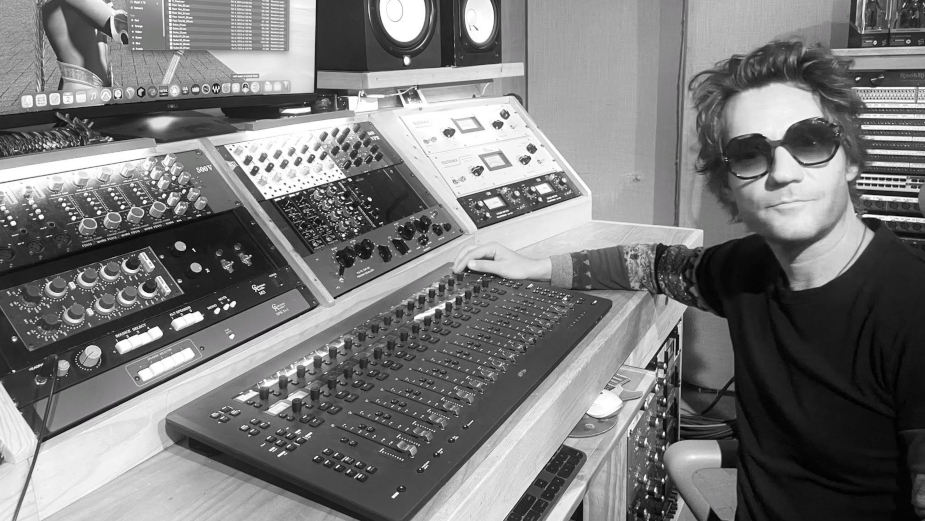
Sonic Boom: The Art of Sound with Christophe Eagleton

Christophe Eagleton is the founder of Dynamite Laser Beam, a global audio collective represented by WORKPRODUCT, made up of musicians, composers, sound designers, songwriters, and creative artists exploring the frontiers of sound and culture. Dynamite Laser Beam is a group of artists who specialise in sound design, working across various domains, from linear film to live events and everything in between.
Sound is an intriguing phenomenon - it’s a powerful medium that can evoke a range of feelings, from nostalgia and joy to suspense and more. It has held my fascination for as long as I can recall, and it's the driving force behind Dynamite Laser Beam, a global audio collective I've had the privilege of founding.
The Language of Sound
Sound, in my view, is a universal language deeply rooted in the human experience. It traces its origins to our earliest moments, beginning with the rhythmic cadence of a mother's heartbeat in the womb and continuing with the sounds of nature that we have co-evolved with for millennia. Our ears, strategically placed on each side of our heads, serve as finely tuned microphones, capturing the rich tapestry of sound in our world.
It's interesting to reflect on the concept of 'audiophiles,' those who seek out the highest quality stereo systems. They're in pursuit of a high-fidelity experience, but it's worth noting that our ears offer a level of richness and nuance that transcends what any speaker system can reproduce. Sound isn't limited to two channels; it envelops us in a multidimensional soundscape, influencing our physiology and, essentially, our survival.
As a sound designer, my fascination lies in understanding and harnessing this power. How can we use sound to convey emotions, create narratives that resonate deeply with audiences, and elicit specific feelings? It's a question that occupies my mind consistently, and when I approach a project, be it a commercial or any creative endeavour, the choice of notes and the composition of sounds become deliberate brushstrokes on the canvas of human perception.
The Art of Sound
Consider the deliberate choice of notes to evoke nostalgia or sadness. There's a sequence of notes that can tug at heartstrings, triggering memories and emotions that connect us to a shared human experience. The piano, for instance, is an instrument designed to harmonise with the way our ears perceive sound waves, making it a powerful tool for emotional expression in music.
Sound's ability to influence our psychology and physiology serves as a reminder of its capacity to elevate any experience. Whether it's a 30-second commercial spot that aims to take the audience on a thrilling journey or an emotional narrative for a cause campaign, the potential of using music in branding is boundless.
In a recent collaboration with Meta (Instagram) India, I was tasked with crafting soundscapes that would resonate with a distinct cultural context. This venture required a deep dive into the scales of Indian music
and a thorough understanding of its intricacies. It underscored the importance of respecting the historical and sonic heritage of a place when creating audio experiences.
The Power of Sonic Design
An example of sound's potential is our recent collaboration at Comic-Con during an immersive experience for NBC's Quantum Leap. The event was an amalgamation of various NBC IPs into a singular immersive experience. The overarching theme revolved around Quantum Leap, creating an engaging narrative where participants embarked on a journey through various NBC properties, seeking clues to complete their mission.
The objective was to engage participants with a tangible sense of urgency, compelling them to solve a complex puzzle. Sound played a magical role here, provoking a physiological response through auditory stimulation. By incorporating accelerated heartbeats into the soundscape, we succeeded in synchronizing attendees' heartbeats and breathing patterns, quite literally raising pulses in response to our sonic orchestration.
Creating soundscapes for mobile platforms requires meticulous attention to detail, even in traditional linear pieces. We embrace the audacious task of pushing the boundaries of speaker hardware to craft unforgettable experiences. In an era where audio quality often teeters on the precipice of compromise, sound designers need to think outside the box and adapt to the small-screen sonic experiences.
However, sound design isn't without its unique challenges, especially when venturing into mobile experiences. Another example is our work on the Coachella app – where our goal was to capture attention amidst the festival pandemonium while ensuring audibility. To go beyond the challenges, we introduced haptic feedback, adding tactile elements to the auditory experience - a subtle buzz or vibration - to engage more than just the auditory senses.
The Future of Sonic Branding
Sonic branding is a treasure trove of ongoing opportunities. When you hear the iconic McDonald's jingle, it immediately conjures the entire brand in your mind. This power of sonic branding extends beyond fast food, encompassing vehicles, electronics, appliances, experiential delights, retail stores, and much more.
Looking ahead, it is evident that the broader picture holds immense potential. We are always seeking ways to push the boundaries of our work on various platforms, from laptop speakers to 5.1 systems, experiential projects, to traditional broadcasts. We relish the challenge of evoking specific emotional responses and sparking state shifts, always tailored to our client's unique objectives.
We are on the cusp of witnessing a surge in sonic branding, where sound becomes the key to brand identity. Brands and agencies have a unique opportunity to make their mark, one resonant note at a time. The world is listening, and it's time to let your ‘sound’ be heard.













